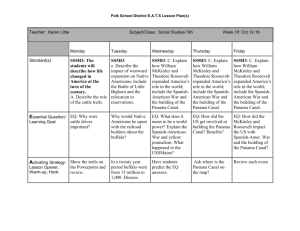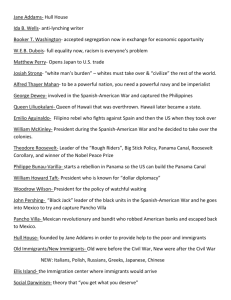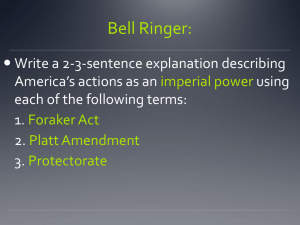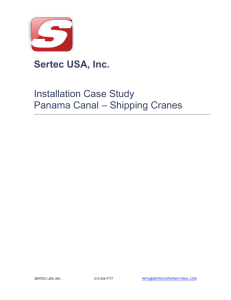Construction of the Panama Canal
advertisement
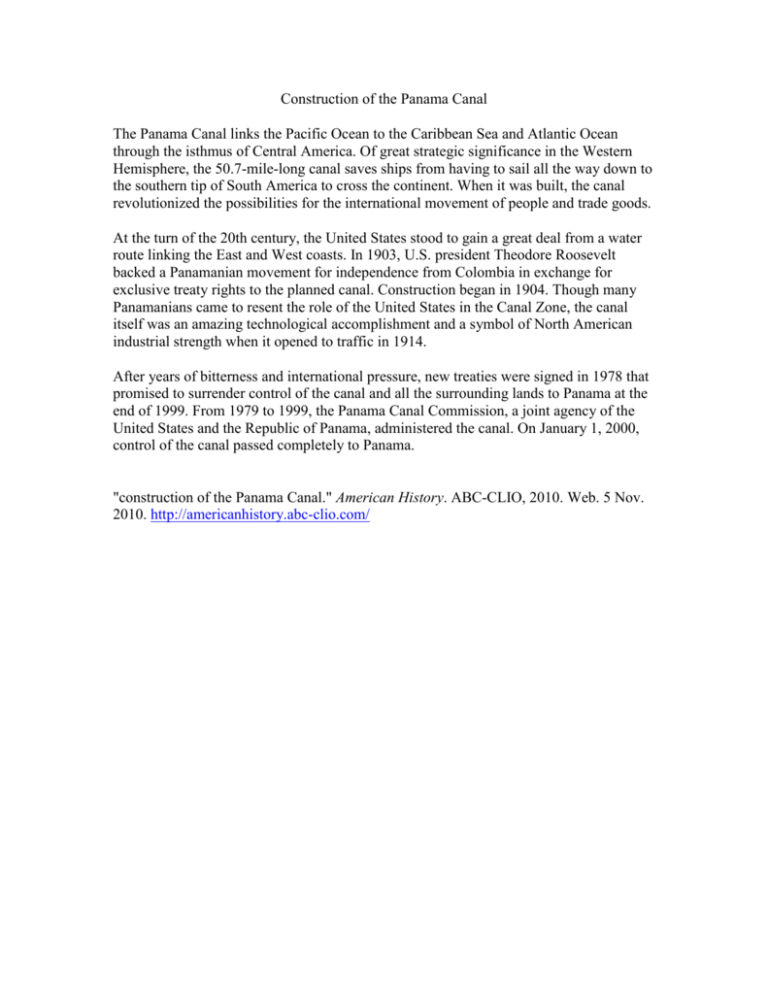
Construction of the Panama Canal The Panama Canal links the Pacific Ocean to the Caribbean Sea and Atlantic Ocean through the isthmus of Central America. Of great strategic significance in the Western Hemisphere, the 50.7-mile-long canal saves ships from having to sail all the way down to the southern tip of South America to cross the continent. When it was built, the canal revolutionized the possibilities for the international movement of people and trade goods. At the turn of the 20th century, the United States stood to gain a great deal from a water route linking the East and West coasts. In 1903, U.S. president Theodore Roosevelt backed a Panamanian movement for independence from Colombia in exchange for exclusive treaty rights to the planned canal. Construction began in 1904. Though many Panamanians came to resent the role of the United States in the Canal Zone, the canal itself was an amazing technological accomplishment and a symbol of North American industrial strength when it opened to traffic in 1914. After years of bitterness and international pressure, new treaties were signed in 1978 that promised to surrender control of the canal and all the surrounding lands to Panama at the end of 1999. From 1979 to 1999, the Panama Canal Commission, a joint agency of the United States and the Republic of Panama, administered the canal. On January 1, 2000, control of the canal passed completely to Panama. "construction of the Panama Canal." American History. ABC-CLIO, 2010. Web. 5 Nov. 2010. http://americanhistory.abc-clio.com/ "Panama Canal Zone." Map. American History. ABC-CLIO, 2010. Web. 5 Nov. 2010. http://americanhistory.abc-clio.com/ Construction of the Panama Canal, ca. 1910. The Panama Canal linked the Pacific and Atlantic oceans over the isthmus of Central America and revolutionized the possibilities for the international movement of people and trade goods. "Construction of the Panama Canal." Image. Library of Congress. American History. ABC-CLIO, 2010. Web. 5 Nov. 2010. http://americanhistory.abc-clio.com/ Theodore Roosevelt and the Panama Canal David C. Hanson, Virginia Western Community College "By far the most important action I took in foreign affairs during the time I was President was related to the Panama Canal," wrote Theodore Roosevelt in his autobiography. In a speech several years after he "took" Panama, Roosevelt explained: "There are plenty of other things I started merely because the time had come that whoever was in power would have started them. But the Panama Canal would not have started if I had not taken hold of it, because if I had followed the traditional or conservative method I should have submitted an admirable state paper to Congress… the debate would be proceeding at this moment… and the beginning of work on the canal would be fifty years in the future. Fortunately [the opportunity] came at a period when I could act unhampered. Accordingly I took the Isthmus, started the canal and then left Congress not to debate the canal, but to debate me." --Theodore Roosevelt Ever since Balboa crossed the Isthmus of Panama in 1513 it was considered the future site of an inter-oceanic passage. In 1898, the Spanish-American War and the emergence of the U.S. as a world power brought new urgency to the problem posed by the long trip around Cape Horn. Roosevelt had advocated a strong navy long before becoming President in 1901, so naturally he was "delighted" when the United States Senate approved the Hay-Herran Treaty in 1903, offering the Colombian government $10 million in cash and an annual payment of $250,000 for a six-mile-wide strip across the Colombian province of Panama. But the Colombian senate refused to ratify the treaty, holding out for $25 million. Roosevelt considered this nothing less than a shake-down and he refused to up the ante. Never known for his patience, Roosevelt was eager to make the dirt fly. While Roosevelt and his foreign policy advisors explored their options, word reached Washington that a revolution was once again brewing in Panama, and that the terms of the treaty recently rejected by the Colombian Senate would be agreeable to the Panamanians. While careful not to endorse the revolt, Roosevelt discreetly let it be known that the U.S. would view this as a positive development and could be counted on to act accordingly. Critics later charged that Roosevelt conspired to instigate the revolution in Panama. In fact, fearing that the U.S. might choose an alternate route through Nicaragua, an enterprising group of Panamanian businessmen--anxious to reap the commercial benefits of the canal--seized the moment. There had been numerous uprisings in the region, and the U.S. had helped suppress them in the past. As Roosevelt later put it, "While I was President I kept my foot on these revolutions… [in this case] I did not have to foment it; I simply lifted my foot." On November 3, 1903, the Panamanian rebels successfully carried out a bloodless coup. Without having fired a single shot, they proclaimed their independence the following day. Without the contingent of U.S. Marines from the gunboat Nashville, which arrived in Panama on November 2, Colombian troops would have squelched the revolt. And the presence of no less than ten U.S. warships standing off shore prevented Colombia from sending in additional troops. The U.S. immediately recognized the Republic of Panama (as did several Latin American nations) and a treaty based on the original offer to Colombia was quickly ratified. Source: Rogers, W.A. “The News Reaches Bogota. Theodore Roosevelt builds the Panama Canal— and shovels dirt on Colombia.” Political Cartoon. New York Herald (Credit: The Granger Collection, NY). December 1903.



